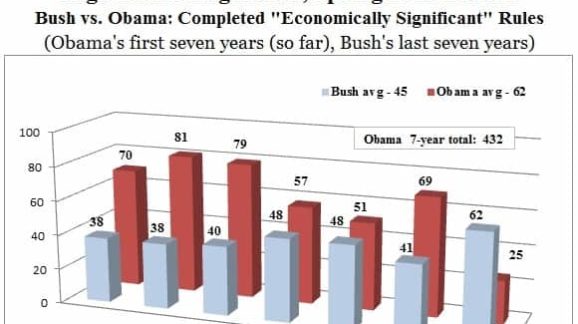Obama Has Issued More “Economically Significant” Rules in 6.5 Years than Bush Did in Eight

It happens to be the case that, in terms of overall counts of rules and regulations published in the Federal Register as final rules, the George W. Bush administration tops that of Barack Obama.
In its first six years, The Bush administration issued 24,241 rules; an average of 4,040 annually.
The Obama Administration, in its first six years, issued 21,804, for an average so far of 3,634 each year.
That Republicans are heavy regulators is no surprise. Books have been written about business as usual under the GOP once it gains power. News reports today in fact illustrate that Republicans will extend Obamacare subsidies in the event of a Supreme Court decision finding them illegal in the dozens of states that didn’t set up their own health care exchanges.
That means future Republicans candidates in the America of tomorrow are likely to defend positive rights to Obamacare funded by others either with or without a Supreme Court victory this month, just as they now do with respect to programs like Medicare and Social Security spawned by their progressive nominal opponents. (Alternatively, rising insurance rates could lead to insurance company demonization sufficient enough to effect the transformation to a single-payer system that some planners preferred in the first place; if that happens, Republicans will ultimately defend that too.)
But enough venting, back to the flow of rules and regulations.
Over the past several years, the Obama “pen and phone” and his promises to go around Congress has brought a lot of new regulation and intervention, but the overall counts of regulations aren’t enough to tell the full story. In the new spring 2015 Unified Agenda of Federal Regulations, which lists agency priorities on proposed and planned rules while also cataloging recently finalized ones, the more costly subset of rules, known as “economically significant,” are considerably higher in the Obama administration.
The chart nearby shows economically significant regulations issued during the final seven years of the Bush administration in blue, and the first seven years, so far, of the Obama administration.

The first year of the Obama administration (his Spring 2009 agenda) likely captures some that Bush issued while still in office through most January of that year. In fact, when it gets aggressive, this bipartisan phenomenon of shoving regulations into the next guy’s calendar year is known as “midnight regulation” and scholars at the Mercatus Center and experts like Susan Dudley of the George Washington University Regulatory Studies Center in particular examine it often.
In any event, if you look at the far right, you can see the 25 economically significant regulations finalized in the Obama administration’s spring 2015 Unified Agenda peeking out behind the last Bush column. We still have the fall 2015 Unified Agenda yet to come, but notable at a glance is that Obama’s overall flow of this costly subset of rules is higher than Bush.
The total number of Bush rules you see there is 315 over seven years, while the total number of Obama rules is 432, when his seventh year is not even completed.
Even adding in Bush’s first year (not shown), which boasted a record for him of 75 completed rules (well, not just “him”; Bill Clinton’s late regulations play some role) gets him to 390. That means in 6.5 years, president Obama has issued more economically significant rules than Bush did in eight.
On average, Bush gave us 45 completed economically significant rules annually. Obama’s average so far is 62, which will rise a good bit by year end. There’s still time to cap the pen and hang up the phone. That goes for both parties.